Henkel Sustainable Packaging
TYPE
Sustainability Innovation
ROLE
Product Designer & Sustainability Consultant
DURATION
10 Weeks
ORGANIZATION
Schoolab
A collaborative project with Henkel to reimagine consumer product packaging through modular, sustainable design solutions that reduce plastic waste while enhancing user experience.
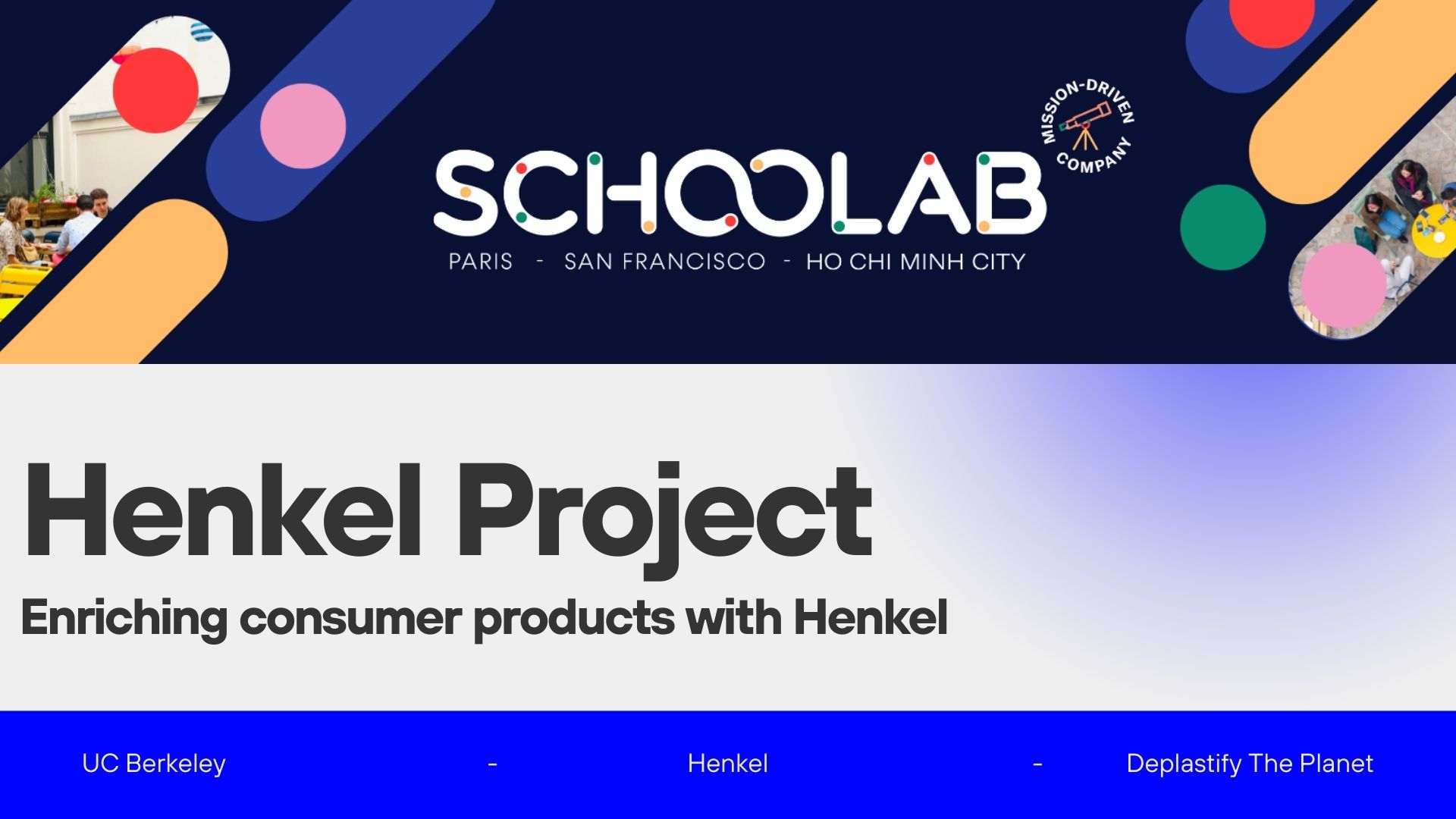
The Challenge
Henkel, a global leader in consumer and industrial products, partnered with the Deplastify the Planet initiative to address a critical challenge: how to reduce plastic waste in consumer packaging without compromising product quality or user experience. Our team was tasked with developing innovative, sustainable packaging solutions that could be implemented across Henkel's diverse product lines.
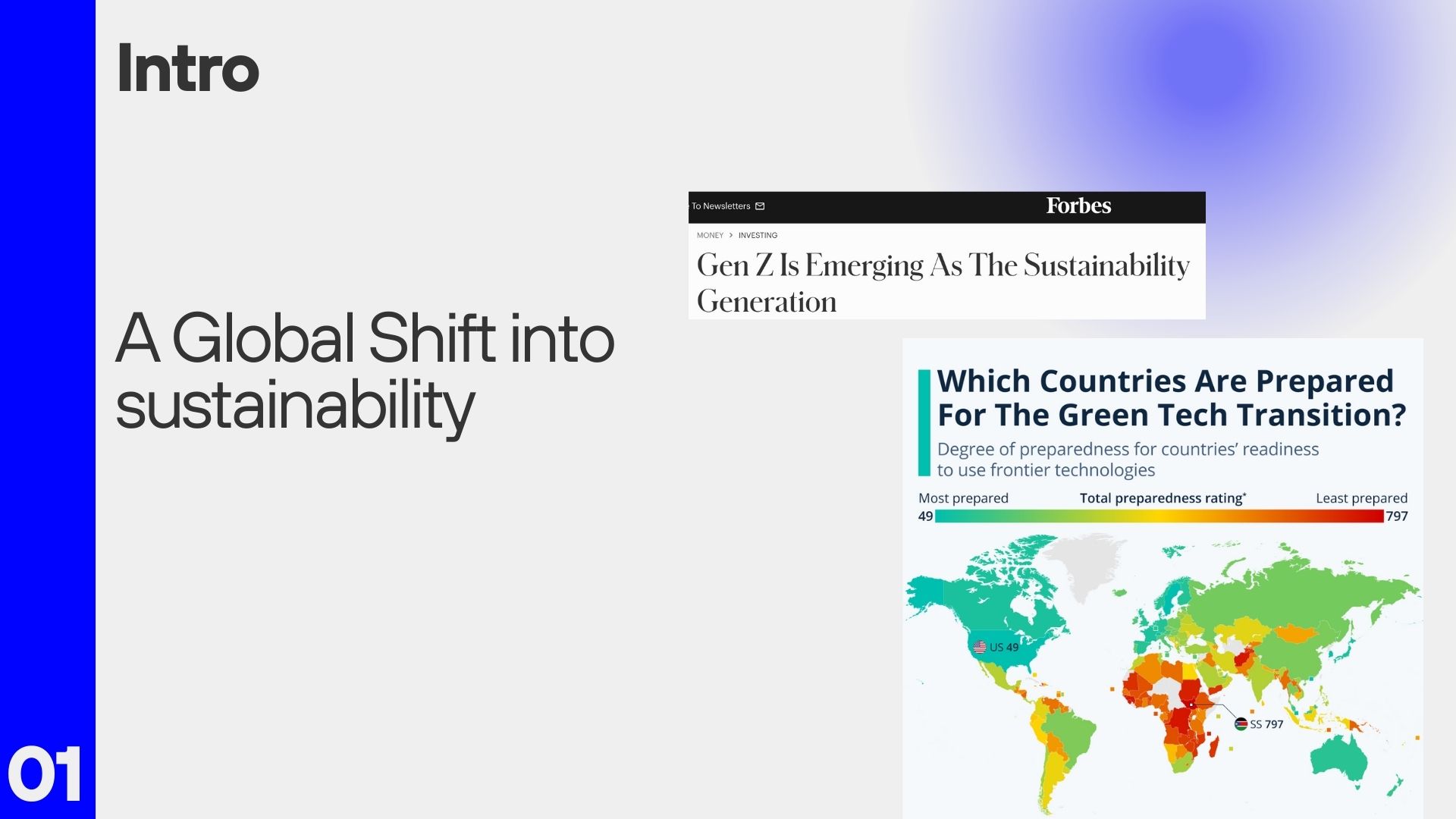
The global shift toward sustainability is being driven by Gen Z consumers and varying levels of country readiness
Project Goals
- Reduce single-use plastic in consumer product packaging
- Design modular systems that encourage reuse and refilling
- Create solutions that enhance rather than compromise user experience
- Develop concepts that are feasible for large-scale manufacturing
- Address the entire lifecycle of packaging from production to disposal
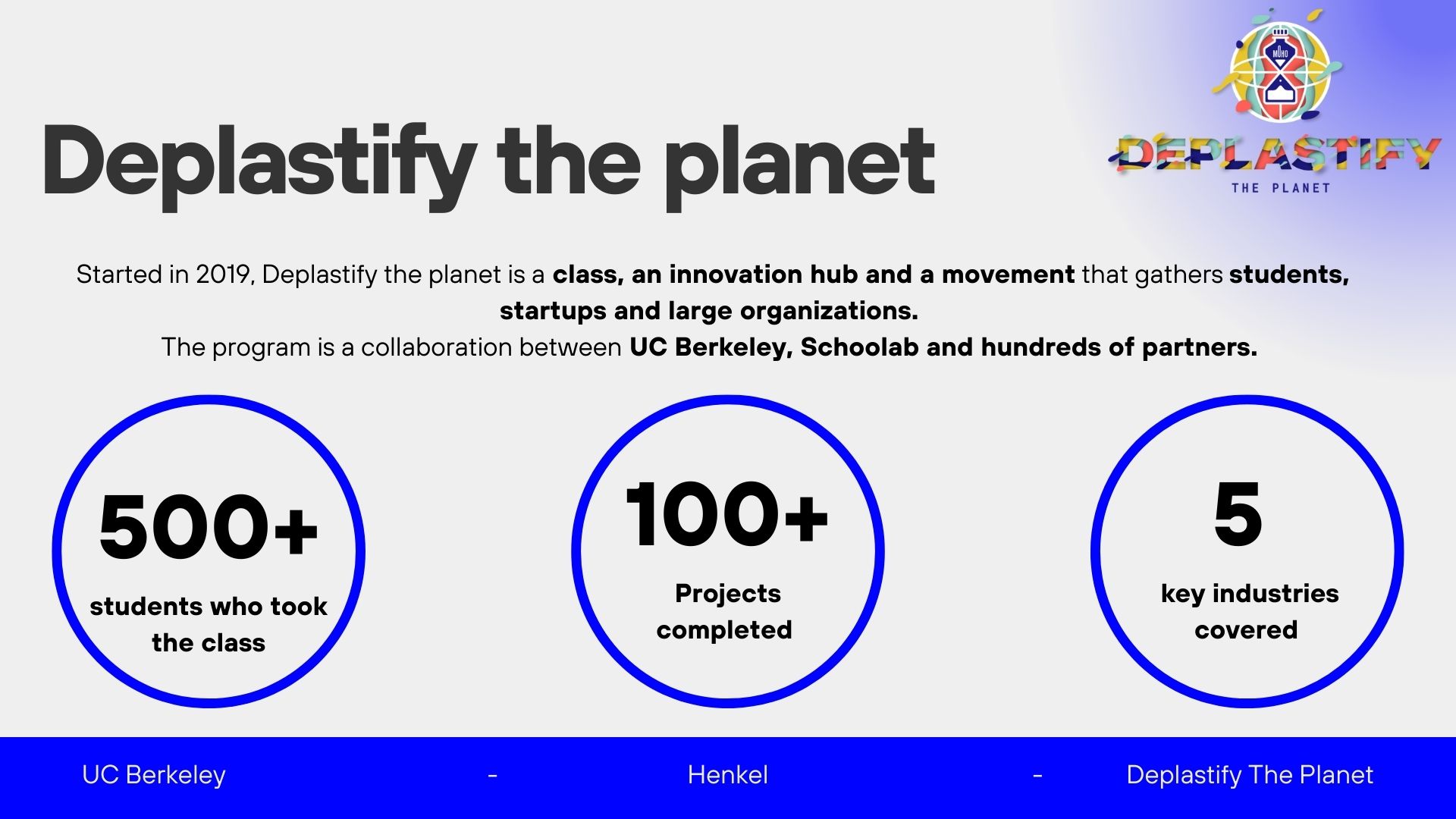
The Deplastify the Planet initiative: a collaboration between UC Berkeley, Schoolab, and industry partners
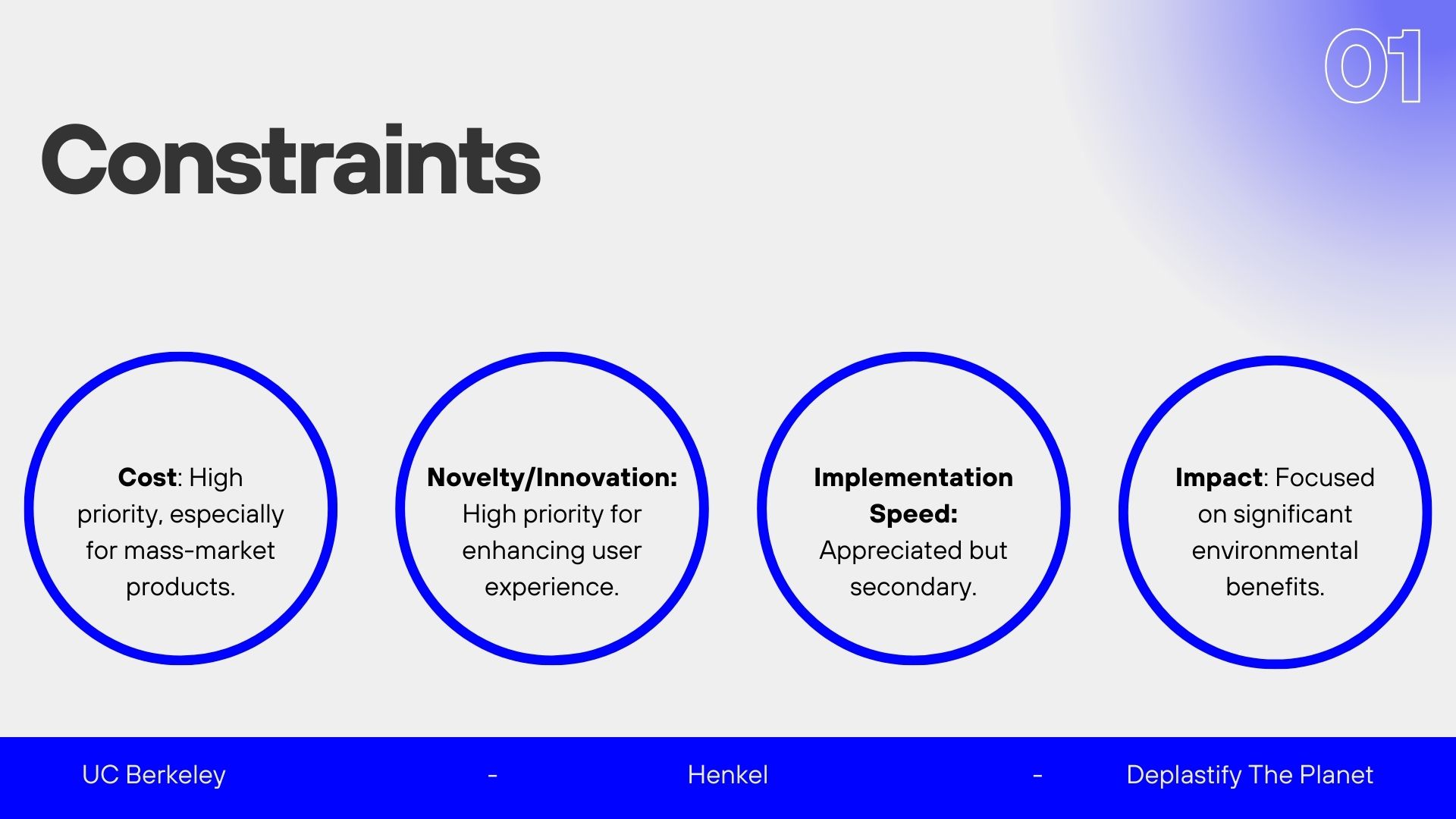
Key project constraints that guided our design approach

Our interdisciplinary team brought together expertise in product design, materials science, and sustainability

Our interdisciplinary team included materials, product, and sustainable design experts
Research & User Insights
Our research phase involved analyzing consumer behavior, studying existing packaging solutions, and identifying key pain points in the current product experience. We conducted interviews with consumers, sustainability experts, and Henkel's manufacturing team to gain a comprehensive understanding of the challenges and opportunities.
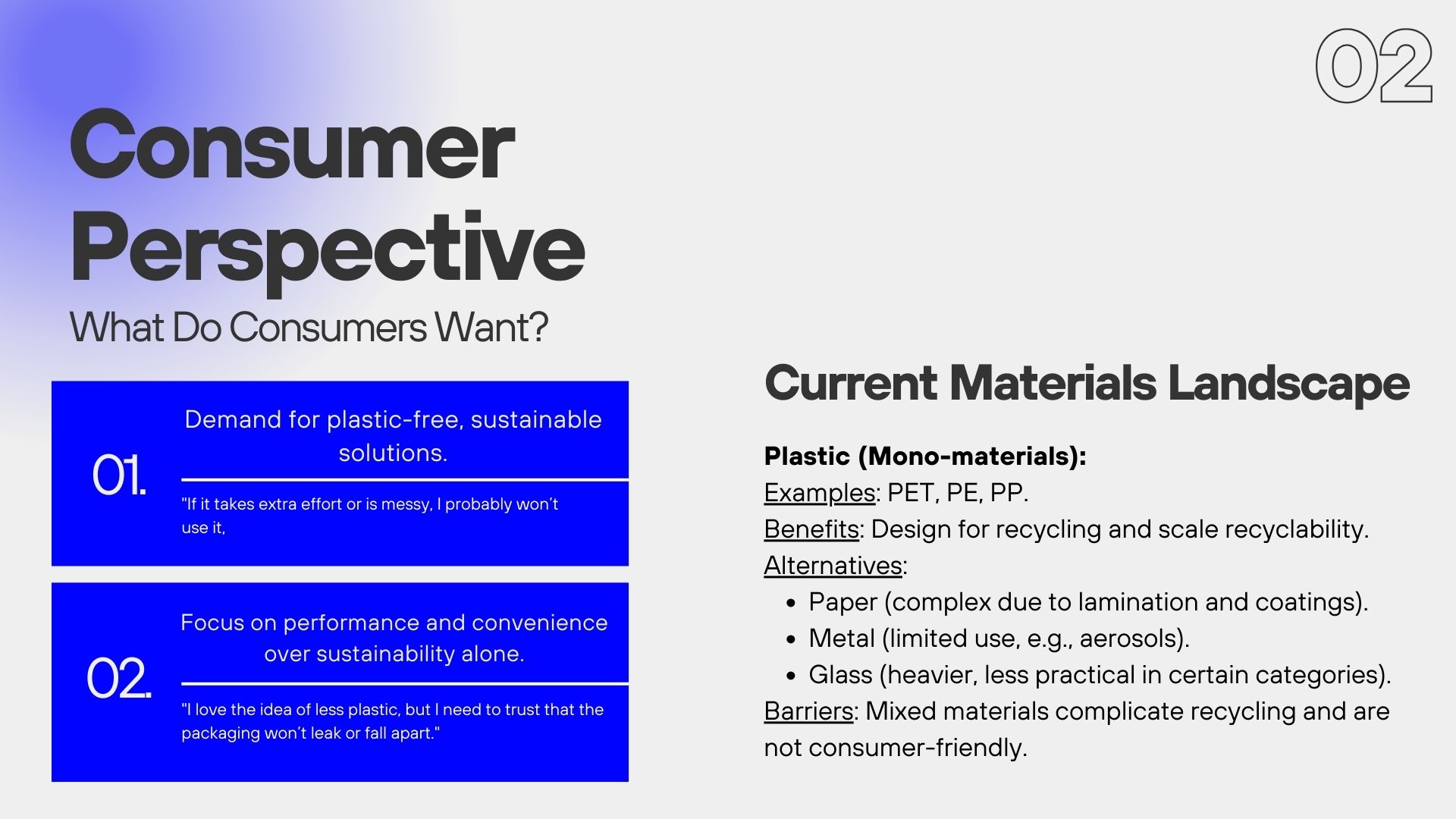
Consumer perspectives on sustainable packaging and the current materials landscape

Key consumer insights that informed our design decisions
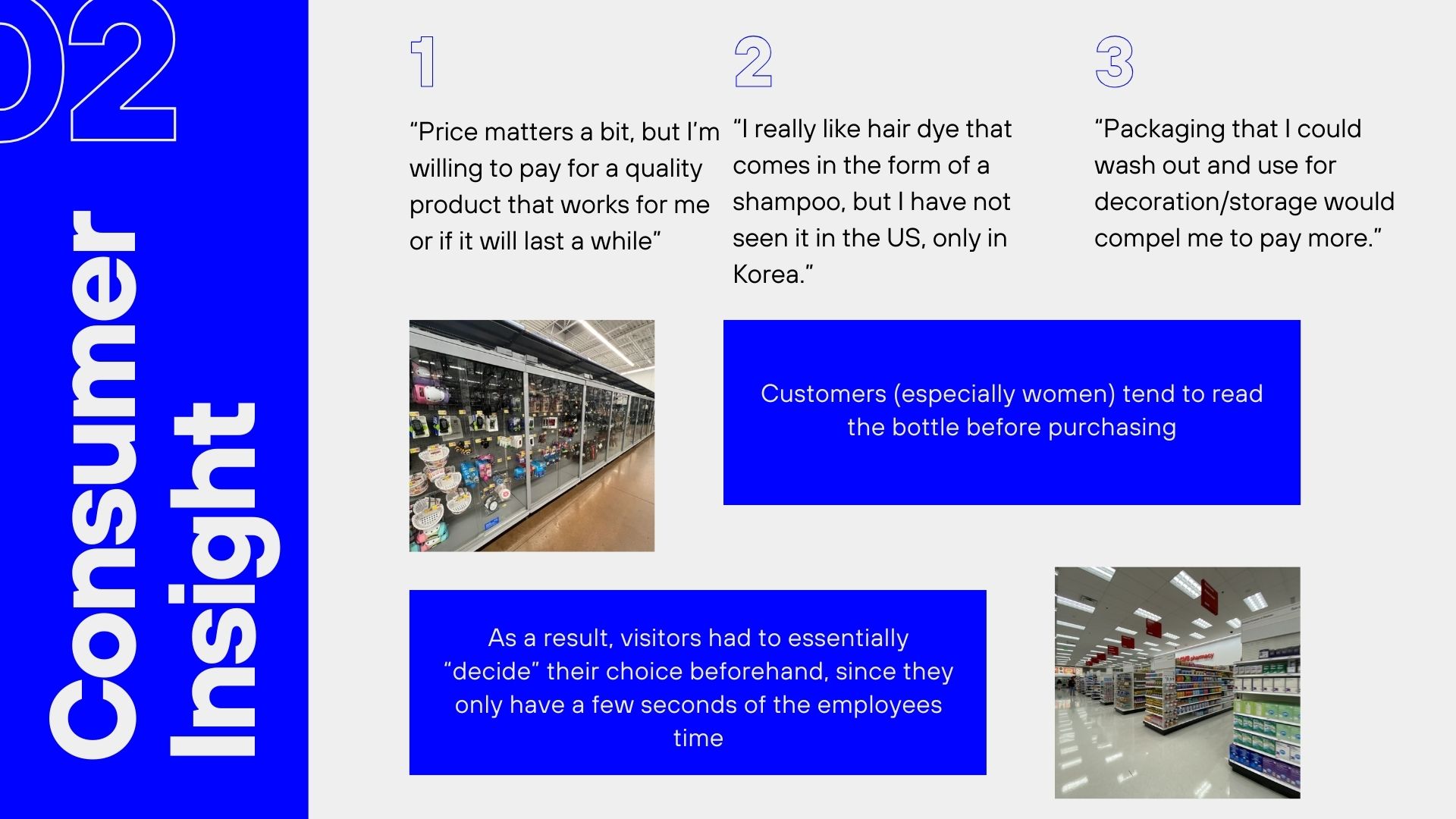
Direct consumer quotes that guided our understanding of user needs and preferences

User persona representing our target demographic
User Persona Insights
We developed detailed user personas to understand our target consumers. Kelly, a 22-year-old health administrator from Los Angeles, represents our key Gen Z demographic:
- Shopping Habits: Shops at large retailers like Target and Costco, buys in bulk for her family, and occasionally visits eco-conscious stores
- Research Behavior: Heavily researches brands to protect her family from harmful chemicals
- Sustainability Preferences: Values biodegradable packaging that doesn't require extra effort, child-proof designs, and clear eco-labeling
- Quote: "Packaging does not affect my decision very much to be honest because I'm going by the product quality itself as it was recommended to me"

Key consumer insights that informed our design direction
Key Research Findings
- Value Perception: Consumers are willing to pay more for quality products that last longer or offer additional benefits
- Novel Formats: Interest in innovative product formats like hair dye in shampoo form, which are common in markets like Korea but not widely available in the US
- Reusable Packaging: Strong interest in packaging that could be washed out and repurposed for decoration or storage
- Shopping Behavior: Customers (especially women) tend to read product bottles before purchasing, but only have a few seconds to make decisions in-store
- Waste Accumulation: The average household discards over 40 pounds of plastic packaging from personal care and cleaning products annually
- Consumer Friction: 78% of consumers report frustration with product waste left in traditional bottles
- Sustainability Gap: 65% of consumers want more sustainable options but are unwilling to sacrifice convenience
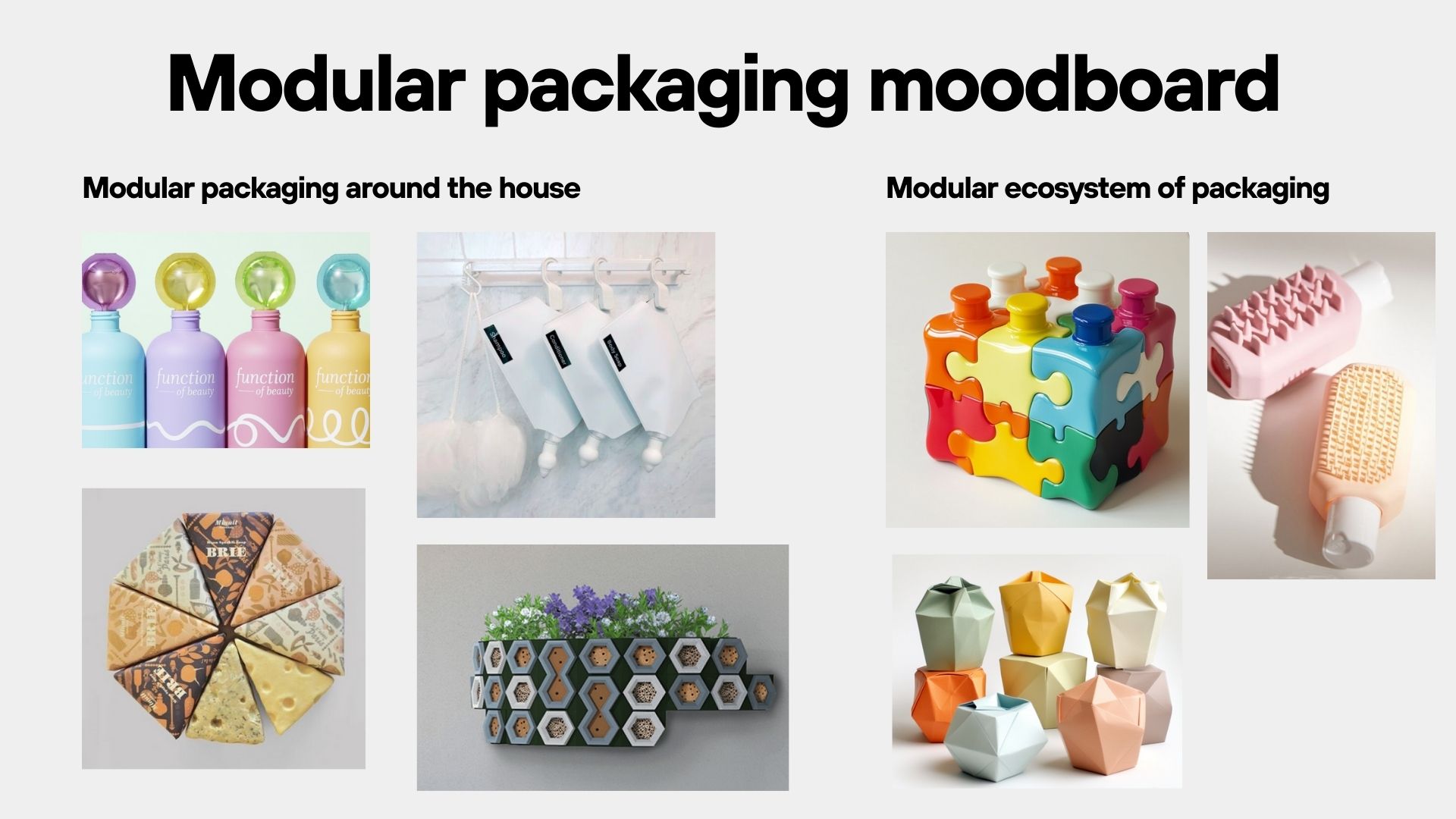
Inspiration moodboard exploring modular packaging concepts for home environments
Shampoo Pellets: A Sustainable Solution
Based on our research insights, we developed a revolutionary concept: solid shampoo pellets that eliminate the need for liquid products in plastic bottles. This approach drastically reduces plastic waste while addressing consumer needs for convenience and effectiveness. We designed multiple dispensing systems to make these pellets easy and enjoyable to use.
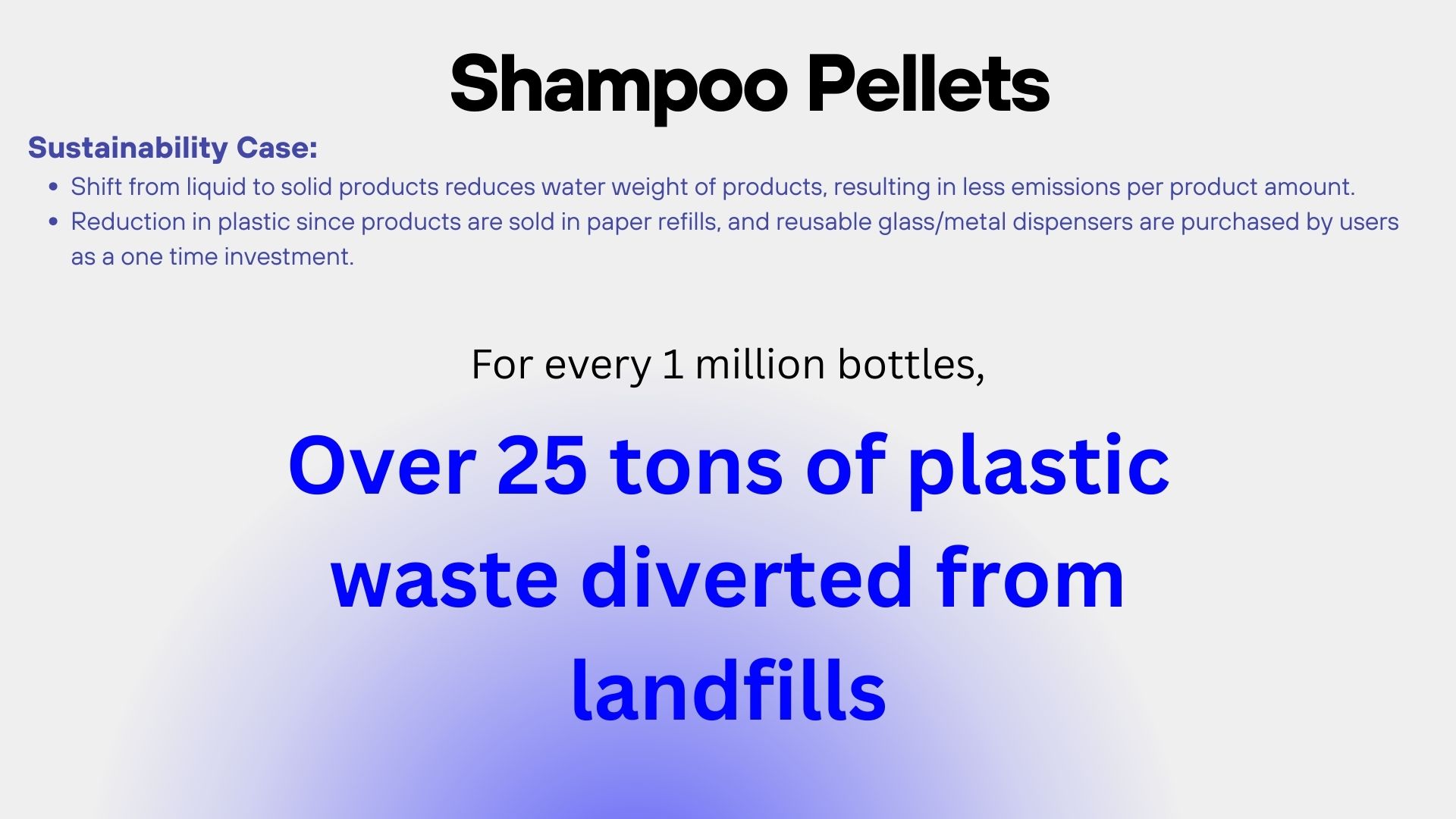
The sustainability case for shampoo pellets: over 25 tons of plastic waste diverted from landfills per million bottles

Market analysis of comparable solid personal care products
Concept 1: Nostalgic Gumball Dispenser
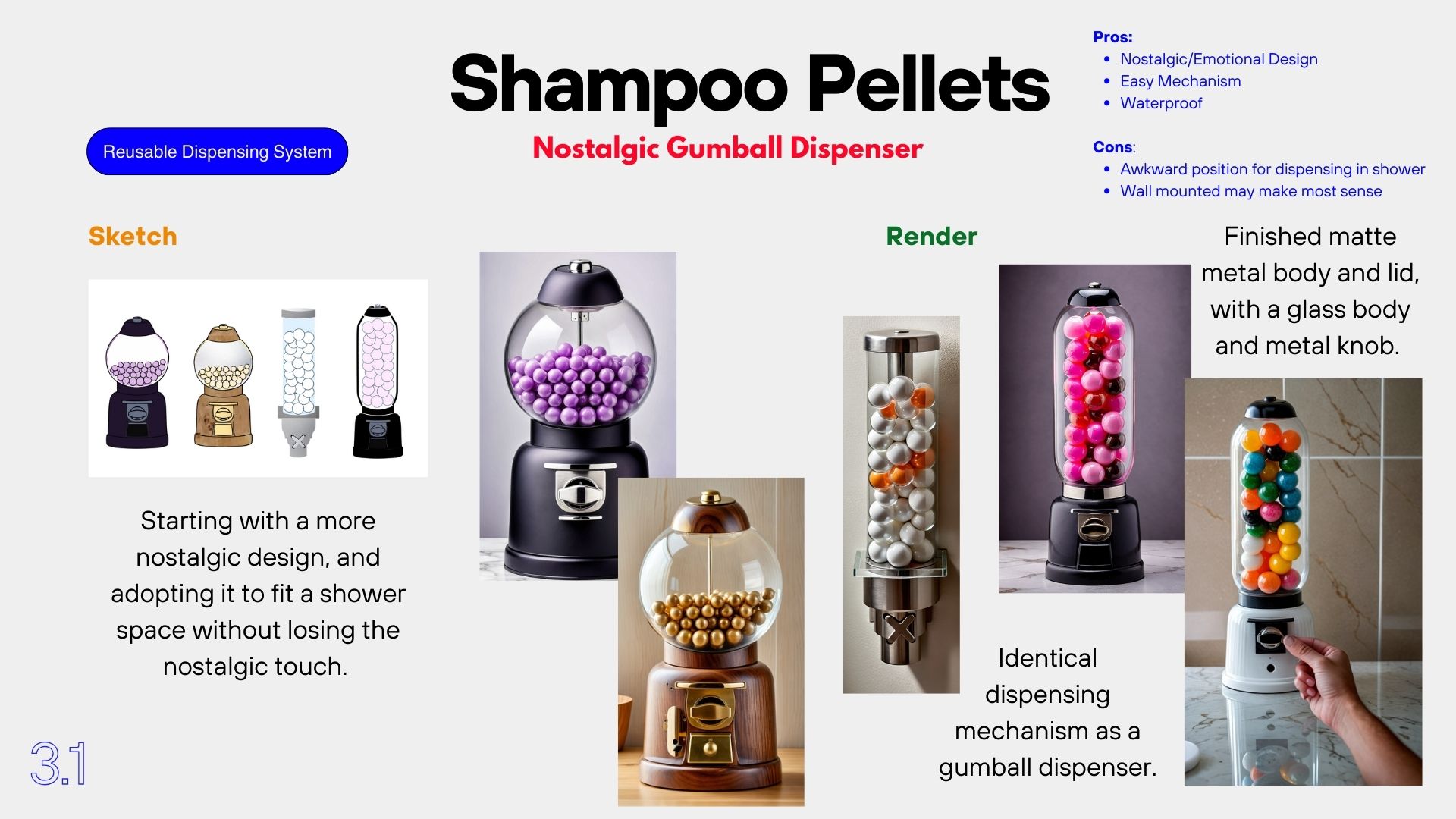
This concept reimagines the classic gumball machine as a shower-friendly dispenser for shampoo pellets. Starting with a nostalgic design and adapting it for the shower environment, this dispenser creates an emotional connection while delivering practical functionality.
Key Features:
- Nostalgic, emotionally engaging design
- Easy-to-use mechanism familiar to most users
- Waterproof construction for shower use
- Finished with matte metal body and lid, glass body, and metal knob
- Wall-mounting option for convenient placement
Concept 2: Silicone Squeeze Dispenser
The Silicone Squeeze Dispenser offers a modern, sleek solution for dispensing shampoo pellets. With its simple squeeze mechanism and minimalist design, this concept prioritizes ease of use and water resistance in the shower environment.
Key Features:
- Sleek and waterproof design
- Easy and accessible squeeze usability
- Mono-material construction with just two parts
- Silicone squeeze dispensing lid with metal or plastic body
- Refillable bottom lid for easy replenishment
Concept 3: Weighted Flip Dispenser

The Weighted Flip Dispenser uses a familiar mechanism adapted from liquid dispensers. When tilted upside down, the weighted pour spout automatically opens to dispense pellets, then closes when returned to an upright position, preventing water from entering the container.
Key Features:
- Easiest and simplest mechanism to use
- Familiar operation to most consumers
- Metal and/or glass body with metal lid
- Weighted simple flip mechanism
- Automatic operation when tilted
Concept 4: Click Portioned Dispenser
The Click Portioned Dispenser offers precise control over the amount of shampoo pellets dispensed. With its innovative clicking mechanism that can be pushed when the bottle is tilted downward, this design prevents water from entering while ensuring consistent portioning.
Key Features:
- Allows portioned dispensing for consistent use
- Uses an easily designed mechanism with catch system
- Recycled plastic or frosted glass container options
- Exchangeable lids for different product types
- Travel size container option available
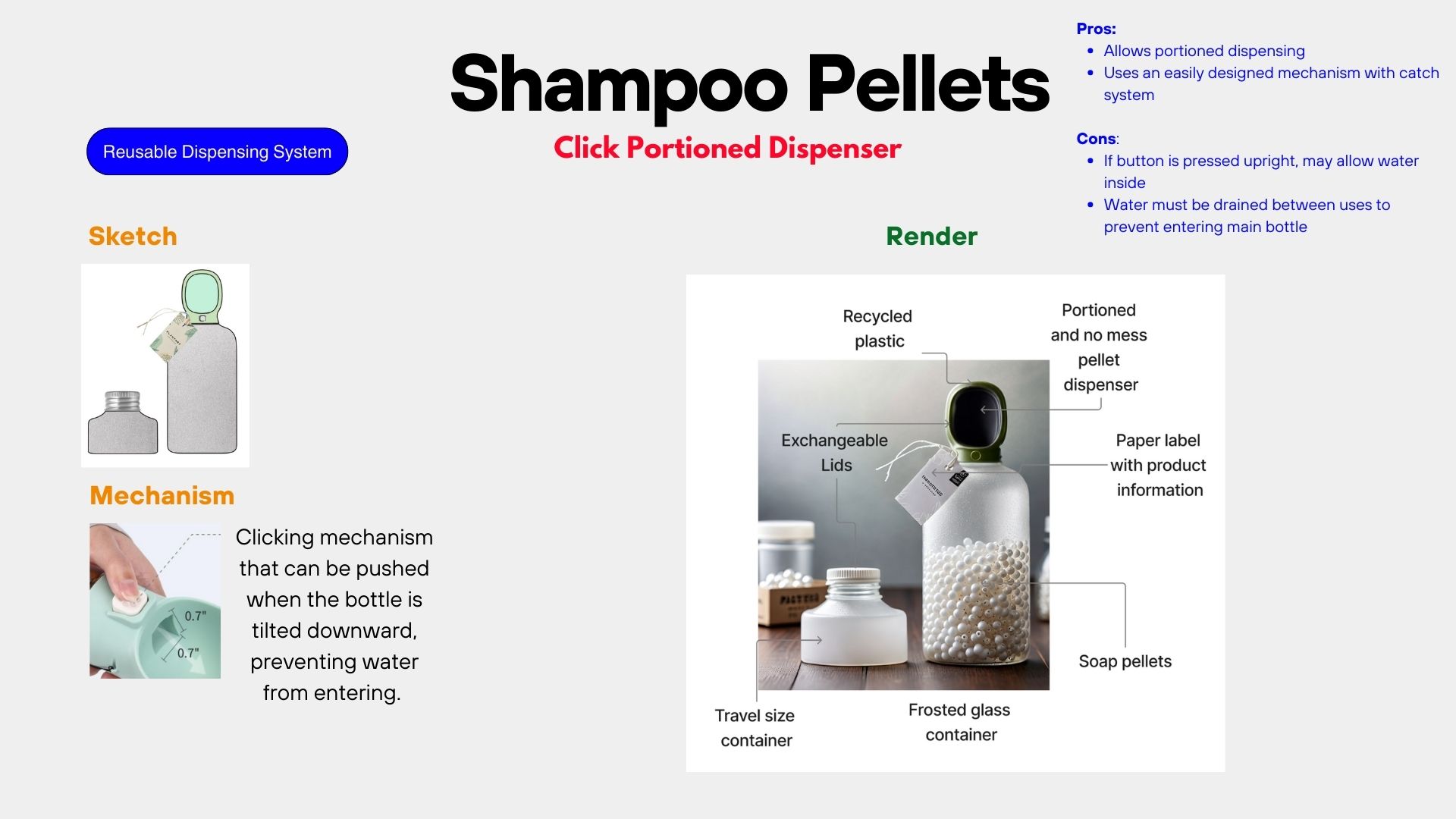
Sustainable Refill Options

To complete the circular system, we designed two refill packaging options that minimize environmental impact while maintaining product integrity:
Hard Shell Refill:
- Brand-embossed aluminum/steel resealable lid
- Paper or bagasse tube body with minimal instruction labeling
- Textured/molded paper for premium feel
- Fully recyclable or compostable materials
- Elegant bathroom counter display
Flexible Refill:
- Simple kraft paper bag with roll-top closure
- Minimal packaging material usage
- Lower shipping weight and volume
- Fully compostable construction
- Cost-effective production
Prototyping & Testing
We developed functional prototypes for each concept and conducted user testing to evaluate their effectiveness, usability, and appeal. The prototypes were refined based on feedback from both consumers and Henkel's manufacturing experts.
User Testing Insights
- Nostalgic Gumball Dispenser: Highest emotional appeal, with users responding positively to the playful experience
- Silicone Squeeze Dispenser: Rated most practical for everyday use, particularly appealing to minimalist-oriented consumers
- Weighted Flip Dispenser: Most intuitive to use without instructions, familiar mechanism from other products
- Click Portioned Dispenser: Appreciated for consistent dispensing, though some users needed demonstration
- Refill Packaging: Hard shell option preferred for gifting and first purchase, flexible option preferred for subsequent refills
Technical Feasibility
- Material Selection: Identified bio-based plastics, recycled metals, and compostable paper products that meet Henkel's performance requirements
- Manufacturing Scalability: Assessed production methods and costs for each concept, with the Weighted Flip Dispenser requiring the least retooling
- Pellet Formulation: Worked with Henkel chemists to develop solid shampoo pellets that dissolve quickly and perform comparably to liquid products
- Water Resistance: Tested all dispensers for water ingress during typical shower conditions
- Lifecycle Assessment: Conducted preliminary environmental impact analysis showing 70-85% reduction in plastic compared to traditional bottles
Implementation Strategy
Based on our research and testing, we developed a phased implementation strategy for Henkel to introduce these sustainable packaging solutions to the market.
Phased Approach
Phase 1: Market Testing (6-12 months)
- Launch limited edition Nostalgic Gumball Dispenser with premium hair care line to generate buzz and consumer interest
- Introduce shampoo pellet formulation in existing packaging to familiarize consumers with the product format
- Conduct in-store demonstrations and sampling to educate consumers on benefits and usage
Phase 2: Mainstream Introduction (12-24 months)
- Roll out Weighted Flip Dispenser as the primary packaging solution for mass market
- Expand pellet formulations across shampoo, conditioner, and body wash categories
- Introduce both hard shell and flexible refill options through retail and e-commerce channels
- Launch subscription model for regular refill delivery
Phase 3: System Expansion (24-36 months)
- Introduce Silicone Squeeze and Click Portioned Dispensers for different consumer segments
- Expand product line to include specialty hair treatments and household cleaners in pellet form
- Develop in-store refill stations in partnership with major retailers
- Phase out traditional plastic bottles for targeted product categories
Results & Impact
Our sustainable packaging concepts were well-received by Henkel's innovation team and selected for further development. The project demonstrated significant potential for environmental and business impact.
Potential reduction in plastic usage across product lines
User preference for sustainable packaging options
Projected increase in brand loyalty from sustainability initiatives
Long-term Vision
The concepts developed through this project contribute to Henkel's broader sustainability goals, including:
- 100% of packaging designed for recyclability or reusability by 2030
- 50% reduction in virgin plastic from fossil sources by 2025
- Zero waste to landfill across all manufacturing sites
- Creating a circular economy model where packaging materials are continuously reused and recycled
Reflections
Working on the Henkel sustainable packaging project provided valuable insights into the challenges and opportunities of designing for sustainability at scale. The experience highlighted the importance of balancing environmental impact with user experience and business viability.
Key Learnings
- Understanding user personas and shopping behaviors is crucial for creating sustainable solutions that will actually be adopted
- Emotional design elements like the nostalgic gumball dispenser can make sustainable choices more appealing
- Offering multiple dispensing options allows for personalization while maintaining a consistent refill system
- Solid product formulations combined with reusable dispensers offer the greatest potential for plastic reduction
- Collaboration between designers, materials scientists, and business stakeholders is essential for developing viable solutions
- Consumer education remains a critical component of successful sustainable packaging implementation